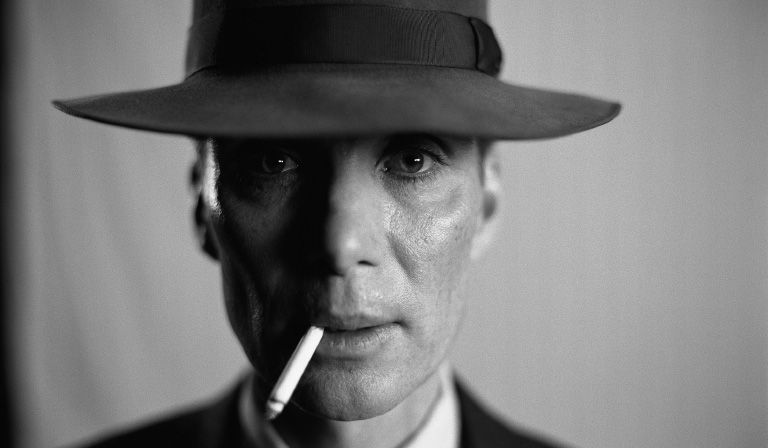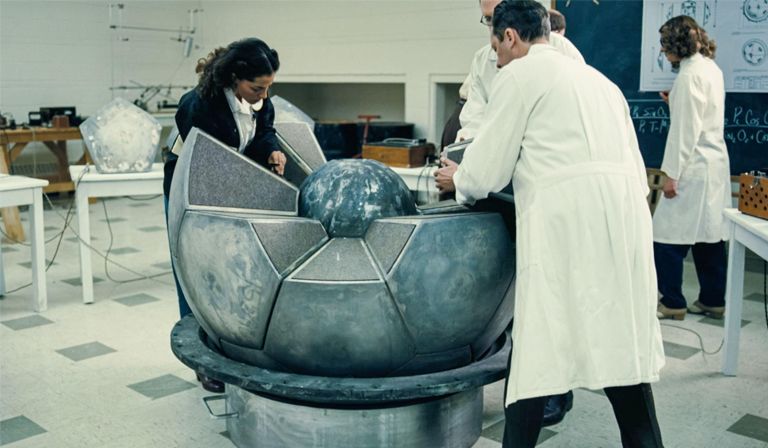The atomic bomb was always destined for stardom. Its cultural shadow was long, even before the first mushroom cloud rose from the American desert.
At Los Alamos, New Mexico, the scientists of the top-secret Manhattan Project seemed to intuit that this was so. When they weren’t conducting the most dangerous experiments in history, trying to beat the Nazis in the race to create a nuclear weapon, they immersed themselves in creative performance. As the countdown ticked away to the decisive (and successful) Trinity Test of the so-called “gadget” on 16th July 1945, the scientists filled their evenings with song, amateur dramatics and performance.
J Robert Oppenheimer, the director of this $2bn mission, put on a production of Joseph Kesselring’s Arsenic and Old Lace. In the Fuller Lodge dining hall, Edward Teller—the Hungarian-American theoretical physicist who would go on to become the father of the H-bomb and Oppenheimer’s mortal foe—played on his Steinway grand piano. Otto Frisch, an Austrian-British scientist and world-class pianist, would also entertain his colleagues in the evening.
By day, the team’s work—depicted in Christopher Nolan’s epic new movie Oppenheimer (in cinemas from 21st July)—sent its prodigiously talented members hurtling towards the deadliest recesses of quantum physics and the production of a bomb that might, conceivably, set fire to the Earth’s atmosphere. Small wonder that they relished cultural distraction when they were off-duty.
Yet there was always more to it than that. The powers with which they were experimenting would test the very limits of the imagination. The bomb was the most terrifying thing in the world. It was also the most transfixing spectacle ever seen by humankind.
“This is the greatest show on earth,” Captain Harold Kinne told his men in 1953 at the Yucca Flat testing site in Nevada. “Relax and enjoy it.”
As crass as such fairground-attraction language sounds, Kinne was on to something. The atomic bomb could not be contained by science, politics, military strategy or the espionage of the Cold War. It drilled deep into the human psyche, demanding an audience. It exploded culturally, as well as physically.
As early as 1946, Albert Einstein became embroiled in a row with Louis B Mayer about a film planned by MGM on the making of the bomb. Initially, Einstein, though “not much of a moviegoer”, told the studio mogul that the script inadequately reflected “the point of view of humanity”.
Yet Mayer’s team persisted, declaring in a memo that US president Harry Truman was “most anxious to have the picture made” and that “dramatic truth is just as compelling a requirement to us as veritable truth is to a scientist”.
Here was a film studio daring to tell Einstein that the shtick of movie-making was as important as the rigours of science. Was he furious? Not a bit.
Tweaks were made to the screenplay and he agreed to the “use of my name on basis of the new script”. The magus of modern physics was profoundly aware of the moral dilemmas that his work had posed. But—like his colleagues—he was not immune to the lure of showbusiness, to association with a big-ticket movie, and to the iconic role of the hero-scientist.
Nolan’s new movie traces the dualities, tension and neuroses that afflicted Oppenheimer—played by Cillian Murphy, pictured—whom the director describes as “the most important person who ever lived”. In spite of his well-known arrogance and many contacts with US Communist party members, he was selected to lead the Manhattan Project by Brigadier General Leslie R Groves (Matt Damon), who believed that his intensity of character and prodigious intellect could be harnessed to win the war.
By the time the bomb was ready, the Nazis had been defeated. But Truman believed that it should still be used to bring an end to the Pacific War and to prevent hundreds of thousands of deaths in a protracted battle on land with the Japanese.
On 6th August 1945, the B-29 “Enola Gay” dropped a bomb nicknamed “Little Boy” on Hiroshima, killing 70,000 and injuring 70,000 more. Three days later, a second bomb, “Fat Man”, killed 40,000 in Nagasaki and injured another 60,000. On 14th August, the Japanese accepted the US terms of surrender.
Nolan’s movie, which is based on Kai Bird and Martin J Sherwin’s Pulitzer prize-winning biography, American Prometheus (2005), explores Oppenheimer’s subsequent efforts to limit the terrible fire that he had released. The conscience-stricken scientist’s reward was not only the hostility of Teller (Benny Safdie) but a campaign led, successfully, by Lewis Strauss (Robert Downey Jr), chairman of the US Atomic Energy Commission, to revoke his security clearance.
By unsettling coincidence, Oppenheimer is hitting our screens when nuclear conflict has become a clear and present danger for the first time since the collapse of the Soviet Union. During the war in Ukraine, Vladimir Putin has warned the western world that he is ready, if provoked, to deploy his 6,000 warheads. “We won’t brag about them,” he said in April 2022. “But we will use them.”
Suddenly, long-slumbering terror has been awoken, and intensified by the growing instability in Russia sown by the mutiny in June of gangster-warlord Yevgeny Prigozhin.
Since the fall of the Berlin Wall, hell has troubled our collective imagination in different forms: climate disaster, the prospect of malevolent artificial intelligence, fundamentalist terrorism and the next pandemic. But now—as if on an infernal comeback tour—the old and vicious demon of nuclear carnage has returned to haunt us once more.
As the floodlights of memory illuminate afresh the path from 1945 to 2023, it is time to recall that nuclear culture was initially drenched in optimism. Just as the bomb had ended the war, so atomic science was confidently expected to transform travel, power generation, farming and medicine.
As the floodlights of memory illuminate afresh the path from 1945 to 2023, it is time to recall that nuclear culture was initially drenched in optimism. Just as the bomb had ended the war, so atomic science was confidently expected to transform travel, power generation, farming and medicine.
In December 1945, Karl Davis and Harty Taylor, country singers from rural Kentucky, recorded “When the Atom Bomb Fell”—a celebration of “the answer to our fighting boys’ prayers”. The Washington Press Club concocted an “Atomic Cocktail” and Los Angeles burlesque houses featured “Atom Bomb Dancers”.
Oppenheimer’s response to his creation had been to quote the Bhagavad Gita: “Now I am become Death, the destroyer of worlds.” But—for a while at least—such portentous fears were drowned out by relief and even a sense of enchantment.
For a minority of artists and intellectuals, that optimism persisted. In Empire of the Sun (1984), a novel based on his childhood internment by the Japanese in occupied Shanghai during the war, JG Ballard imagines his literary surrogate, Jim, witnessing the firestorm of Nagasaki (impossibly so, given his geographical location): “a flash of light filled the stadium, flaring over the stands in the south-west corner of the football field, as if an immense American bomb had exploded somewhere to the north-east of Shanghai.”
In adulthood, Ballard admired this apocalyptic technology. “I haven’t the slightest sympathy for movements in favour of disarmament, especially our CND,” he said in a 1985 interview. “Far from being an instrument of death, the atomic bomb has become for me an instrument of protection.”
For other writers, the most honest cultural approach to the bomb was to apprehend it literally; to seek to make clear its potential human cost, and its capacity to destroy civilisation in a single gigaton exchange. The pioneer of this mission was the New Yorker journalist John Hersey, whose classic work of reportage, Hiroshima (1946), was initially printed in full in the magazine, of which 500,000 copies were snapped up; the book itself went on to sell more than three million copies.
In cool but unflinching language, Hersey told the world that the city had not been, as Truman claimed, “a Japanese army base”. Instead, he painted vivid portraits of survivors such as the Methodist pastor Kiyoshi Tanimoto, who had run to the aid of a neighbour and watched as, at his touch, “her skin slipped off in huge, glove-pieces”.
A generation after Hersey, the British television director Peter Watkins made The War Game, a pseudo-documentary about the probable after-effects of a nuclear attack on the UK, focused upon the town of Rochester. We see the sudden collapse of basic infrastructure, the pitiful inadequacy of the government’s “civil defence” plan, the spread of disease, the filth and trauma that overwhelms the survivors, and the summary execution of rioters and looters.
The Labour government and BBC alike were appalled by the dystopia envisaged by Watkins—shocking to this day—and cancelled its broadcast, originally set for 6th October 1965. The film was not shown on terrestrial television for 20 years. In 1984, the Mick Jackson drama Threads, written by Barry Hines and set in Sheffield just before and after a nuclear bombardment, caused comparable controversy. If anything, it outstripped The War Game in its depiction of nuclear fallout, depraved barbarity and genetic havoc.
Among nonfiction writers of the 1980s and thereafter, another New Yorker journalist, Jonathan Schell, proved hugely influential with his trilogy of books about the realities of the nuclear age: The Fate of the Earth (1982), The Abolition (1984) and The Unconquerable World (2003). Conspicuous among his disciples was the late Martin Amis, whose collection of short stories Einstein’s Monsters (1987) acknowledges an explicit debt to Schell. “I didn’t know why nuclear weapons were in my life or who had put them there,” he writes of his earliest recognition of their existence, aged 11 or 12. “I didn’t know what to do about them. I didn’t want to think about them. They made me feel sick.”
In one of his most powerful essays, which forms the preface to the book, Amis writes that the threat of nuclear weapons “is the highest subject and it is the lowest subject. It is disgraceful and exalted.” It challenged, he continued, every notion of decency, every human assumption, the meaning of language itself: “All times are different, but our time is different. A new fall, an infinite fall, underlies the usual – indeed traditional – presentiments of decline.”
In this emphasis upon the nauseating immensity of his theme, Amis reflected a broader truth: that much nuclear culture has shied away from naturalism, as if the consideration of what a global abattoir would be like sends reason into a tailspin, forcing the imagination towards escape velocity into the realms of horror, nightmare and grotesque fantasy. Amis was also right to record that atomic culture has surfaced more visibly in genre writing than mainstream fiction.
Dystopian nuclear tales became a subgenre in their own right, of which Walter M Miller Jr’s A Canticle for Leibowitz and Pat Frank’s Alas, Babylon, both published in 1959, remain the most distinguished examples. Graphic novels, especially Katsuhiro Otomo’s stunning cyberpunk manga series Akira (1982–90) and Jonathan Hickman’s The Manhattan Projects (2012–15), brought a new and dynamic aesthetic to this vibrant form.
For the Beat Generation in the 1950s, the bomb was like a permanent migraine. Though rarely a core theme, it seeped into their work; unwelcome but unavoidable. Allen Ginsberg considered nuclear weapons to be “an all-inclusive metaphor” and, in his epoch-defining poem Howl (1954–55), referred both to “monstrous bombs” and to “angelic bombs”. In On the Road (1957), Jack Kerouac described the people of the Sierra Madre Oriental who “didn’t know that a bomb had come that could crack all our bridges and roads and reduce them to jumbles, and we would be as poor as they someday, and stretching out our hands in the same, same way.”
What was going on in such contemplations? Intermittently out of print, but essential to understanding the imaginative impact of nuclear weapons, is Bomb Culture (1968) by the late activist and critic Jeff Nuttall, which captures in a bottle the lightning of generational change. “VE Night took place in one world and VJ Night in another… The first victory was a victory confirming our merits and security. The second destroyed them irrevocably,” he wrote. “[A]t the point of the dropping of the bombs on Hiroshima and Nagasaki, the generations became divided in a very crucial way.”
The new mentality of the disaffected teenager—of James Dean, Elvis, Marlon Brando, the Hell’s Angels, teddy boys, mods and rockers—was, to a considerable extent, the psychological shrapnel of the bomb. For this cohort, the future had simply been abolished. Witness, for instance, the casual nihilism of 16-year-old Holden Caulfield in JD Salinger’s The Catcher in the Rye (1951): “Anyway. I’m sort of glad they got the atomic bomb invented. If there’s ever another war, I’m going to sit right the hell on top of it. I’ll volunteer for it. I swear to God I will.”
Powerlessness is the most frequent refrain of nuclear culture. “We have too many bombs,” wrote Don DeLillo in End Zone (1972). “They have too many bombs. There’s a kind of theology of fear that comes out of this… Now god is the force of nature itself, the fusion of tritium and deuterium. Now he’s the weapon… The big danger is that we’ll surrender to a sense of inevitability and start flinging mud all over the planet.”
The new mentality of the disaffected teenager was, to a considerable extent, the psychological shrapnel of the bomb
As against such exclamations of despair, there is the anger visible in the paintings of Pablo Picasso, whose The Rape of the Sabine Women (1962–63) was a furious response to the Cuban Missile Crisis, and of Francis Bacon, who often spoke of the impact that Hiroshima, like Auschwitz, had upon his aesthetic sensibility. “We have even created bombs capable of blowing up the planet a thousand times over,” Bacon reflected in 1992. “An artist instinctively takes all this into account. He can’t do otherwise.”
And—always battling acquiescence and fatalism—there has been satire, absurdity and the power of scorn. No other work of nuclear culture is as powerful as Stanley Kubrick’s Dr Strangelove or: How I Learned to Stop Worrying and Love the Bomb. Who, meanwhile, can forget the episode of the 1980s comedy classic The Young Ones in which a bomb lands in the students’ house, unexploded, and the hippy Neil (Nigel Planer), holding a copy of the government’s much mocked Protect and Survive manual, paints himself white “to deflect the blast”?
And if the end of the world were to have a soundtrack, nothing could be more fitting or hilarious than the songs of Tom Lehrer. Take “Who’s Next” (1964): “So long, Mom / I’m off to drop the bomb / So don’t wait up for me / But while you swelter / Down there in your shelter/ You can see me / On your TV.”
Laughter in the dark, and the blinding light. Jeff Nuttall put it thus: “The only true disaster is the end of the journey, the end of man and his development… If we get out and on, it will be by art, as always.” It is a noble doctrine. More to the point, it is the best we have.
Nolan’s Oppenheimer will confront us—and this time in thunderous IMAX—with an existential fragility that never really went away. It was only sleeping. Now, it is demanding entrance once again to our dreams, imaginings and trembling souls. Welcome back, Armageddon.
To see Matthew’s list of the top ten nuclear movies, with his commentary, please click here.
















